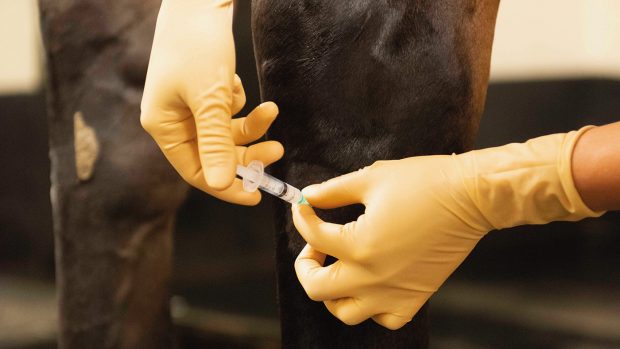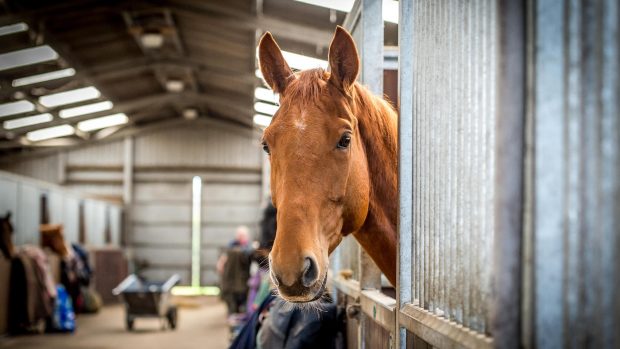Flexion tests can offer clues about a horse’s soundness, so why are they so controversial? Andrea Oakes investigates
There’s a particular point in the pre-purchase examination (PPE) where both buyer and seller wait with bated breath. After a short period with one leg held aloft, will the horse trot away sound — or will he show any signs of lameness? The flexion test on horses has long had its critics, but it remains a valuable part of both the PPE and lameness investigations.
“This is a common procedure that can be carried out in both fore- and hindlimbs,” explains Hetty Hill MRCVS, who works alongside Dr Andre Buthe at his sport horse clinic in Marlborough, Wiltshire. “The process involves manually flexing a horse’s leg for a period of time before releasing it and watching him trot away immediately afterwards. The idea is to stress the joints and surrounding soft tissue structures (the ligaments and tendons), to assess the horse for any deterioration in soundness.
“The horse is trotted in a straight line before and after flexion is performed, and so the same surface must be used to allow for the most accurate comparison,” she adds.
The BEVA (British Equine Veterinary Association) and RCVS (Royal College of Veterinary Surgeons) PPE guidance notes state that flexion tests of all four limbs may be carried out if the examining veterinary surgeon considers it safe and appropriate to do so. While most vets elect to perform flexions on most horses to gain additional information to form an opinion on the suitability of a prospective purchase, there are occasions when the tests are shortened or abandoned.
“Flexion may not be possible with a young or poorly handled horse, or where there are no suitable facilities,” says Hetty. “We are obliged to record all relevant findings on the PPE certificate. If flexion tests are omitted, the vet should document why.”
Confusing the issue
“When the horse trots after flexion, the vet will assess any changes in gait before grading the response,” explains Hetty. “The first consideration is whether there is lameness, or, in the case of an investigation rather than a PPE, any worsening of previous lameness. The degree of lameness is then graded.”
A positive flexion test generally refers to lameness that persists for a number of strides — usually more than three to five. Confusion can arise among owners, however, for two reasons: the way tests are carried out and the interpretation of the results.
Can response differ depending on the force and angle used when flexing the leg, for example, or the duration?
“Research has shown that increased force applied and time spent in flexion amplifies the horse’s response, and that a horse’s age and workload may influence results,” says Hetty. “Although most vets will hold the limb for between 30 seconds and a minute, there is no agreed time for flexion. Neither are there any definitive guidelines as to how many strides of lameness represents a positive result. This is assessed subjectively by the vet.
“The interpretation of the response to flexion may vary slightly between vets, but this is not a problem provided each individual is consistent in his or her approach.”
Hetty explains that there have been various suggestions as to how the flexion test method can be regulated.
“A group of vets from Italy published a study in 2016 where they used a pressure-sensitive glove to standardise the force applied during lower limb flexions,” she says. “This has some potential to minimise one of the variables in performing the test, but it does not eliminate others — such as the subjective nature of the vet’s evaluation of a response to flexion.
“Equine gait analysis systems using motion sensors are also becoming more widely used in the UK,” adds Hetty. “If used appropriately, they can provide a means for evaluating lameness objectively and may be used in recording response to flexion or nerve blocks during a lameness work-up. These systems may be used more commonly in PPEs in the future.”
Flexion test on horses as part of the puzzle
While there is little evidence currently available to link a positive flexion test with future lameness, various studies have tried to bring science to this rather non-specific procedure.
Despite their shortcomings, the flexion test on horses can be a useful “red flag”. The fact that one forelimb responds differently to the opposite one, when tested in the same way, could indicate a problem — but where, exactly?
“When flexing the fetlock, for example, the joint itself is put under pressure — but so are numerous soft tissue structures including the suspensory ligament branches, the flexor tendons and the proximal sesamoidean ligaments,” says Hetty. “Issues with any of these areas may contribute to resulting changes in gait.
“It is not straightforward to isolate specific anatomical areas with accuracy when performing a flexion test. This is particularly true in the hind limb, where the reciprocal apparatus ensures that the stifle and hock move together.
“It is fair to say, however, that the flexion test on horses play an important part in a lameness evaluation — but only if interpreted alongside other findings,” she adds. “Flexion can be useful in exacerbating low-grade lameness to aid your vet in a lameness work-up, and may give an indication of where to start with diagnostic nerve blocks. But the test is just one piece of the puzzle, so the horse’s response must be interpreted in light of other findings.
“The way a horse moves or flexes may give your vet ideas about where the problem could be, but flexion tests alone cannot provide a diagnosis,” says Hetty. “They are not a substitute for other components of an orthopaedic exam, such as manual palpation of the limbs, dynamic gait analysis, nerve blocks and diagnostic imaging techniques.
“Flexion tests have a place in the PPE and in orthopaedic assessments, but their limitations must be understood and acknowledged,” she concludes.
“Don’t be afraid to ask your vet to explain their findings and to give their opinion of how relevant they think these are for you and your horse.”
Should you buy?
“Lameness following flexion does not necessarily mean that a horse is unsuitable for purchase,” explains Dr Andre Buthe. “The general expectation is that a young horse will be sound after a flexion test, while an older horse may show more reactivity — but this is not always the case.
“An older competition horse showing reactivity after flexion may still be suitable, especially if the vet performing the PPE is satisfied with the rest of the orthopaedic evaluation. If a horse has a consistent competition record and has proved his ability to withstand the current workload without needing time off for injury, then it may be worth taking this into consideration when making a decision regarding purchase.
“Instead of focusing purely on the positive flexion test, it is important to find out if the examining vet has any other concerns that may prejudice the horse’s chances of performing the job required. As a purchaser, it may be sensible to consider walking away from a horse that has several other major findings. If the flexion test is the primary problem, however, a thorough orthopaedic assessment may be worthwhile and could help the decision-making.
“Buying a horse is always a balance of risks. If you do go ahead with the purchase, be aware that any findings from the PPE may result in exclusions being placed by your insurance company. And you may well have the same problem with flexion tests in future PPEs — although this is less likely to be an issue if the horse in question gains an outstanding performance record by the time you come to sell.”
What are your views on flexion tests as part of the PPE? Let us know your thoughts by emailing hhletters@futurenet.com, including your name and location, for the chance to have your views published in a future issue of Horse & Hound magazine.
Ref Horse & Hound; 29 November 2018
You may also be interested in…

Understanding flexion tests on horses
H&H looks at the factors that affect the response to flexion tests

Study could lead to ‘unbiased’ flexion tests for horses
Can flexion tests ever be objective rather than subjective? Yes, say researchers involved in a new study that has trialled

The definitive guide to the pre-purchase equine vetting

Subscribe to Horse & Hound this spring for great savings




